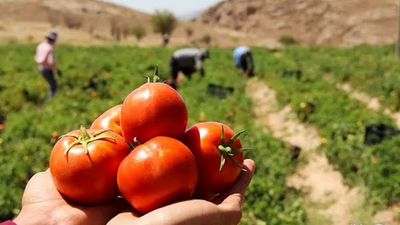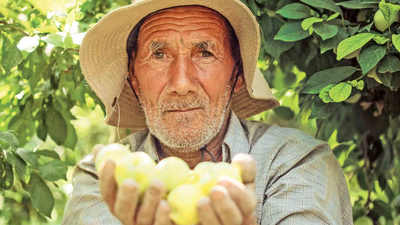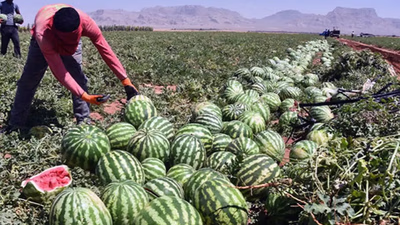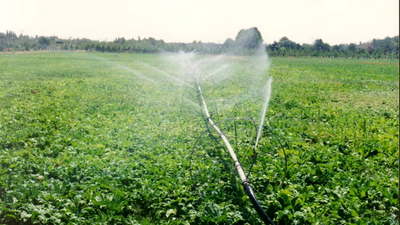
West Asia"s diverse agricultural products include fruits and vegetables."
West Asia is renowned for its date palm cultivation. Countries such as Saudi Arabia, Iran, Iraq, and Egypt are major producers of dates. Dates are a staple food in the region and are also exported worldwide. Wheat and barley are important grains cultivated in West Asia. These crops play a vital role in the region's food security. Countries like Iran, Turkey, and Syria are significant producers of wheat, while Saudi Arabia, Iran, and Jordan are known for barley production. Countries like Turkey, Israel, Lebanon, and Morocco are known for their citrus fruit production. Oranges, lemons, and grapefruits are among the citrus varieties grown in the region. Citrus fruits are consumed locally and exported to international markets.
Regarding the West Asian region, the increase in food demand and limited water and land resources have caused an increase in dependence on the import of basic food. According to forecasts, the production of agricultural products and fish in the "Mena" region will experience an increase of 1.5 percent over the next decade, an increase whose main factor is the improvement of the productivity of the two largest producers in the region, namely Iran and Egypt - with a growth of 2 and 1 percent, respectively. They will be its main engine. West Asia is renowned for its aromatic herbs and spices. Saffron, sumac, thyme, mint, coriander, and cumin are some examples of herbs and spices cultivated in the region. These products are used to enhance the flavor of dishes and are also exported.
Agriculture plays an important role in the economy of many countries in the Middle East and North Africa. The share of the agricultural sector in the economy of the countries of the region varies, which varies from about 3.2 percent in Saudi Arabia to 13.4 percent in Egypt. Examining Iran's agricultural sector is one of the important points of the joint report of "FAO" and "Organization for Economic Cooperation and Development". According to the findings of this joint report, MENA region's agriculture is dominated by two regional giants, namely Iran and Egypt, countries that collectively produce half of the total value of agricultural products.
Egypt is the fourteenth producer of rice and the eighth producer of cotton in the world. In 2011, this country produced about 5.67 million tons of rice and 635 thousand tons of cotton. The cotton cultivation area is about 5% of the cultivated areas in Egypt. The total amount of product residue, which includes dry matter, reaches about 16 million tons per year. Other materials remaining from the cotton crop, which is mainly the cotton stalk, make up about 9% of the total crop residue, which, of course, is currently facing disposal problems.
Despite initial setbacks, Turkey, the world's seventh-largest agricultural producer, is looking to lease prime farmland in several African and Latin American countries to boost agricultural production amid growing global concerns about food security. With a total of 2.5 million hectares of horticultural production and 12 million hectares of cultivated crops, Iran has a valuable position in the production of agricultural products in the world and is one of the top 7 countries producing agricultural products.
Olive trees are widely grown in the Mediterranean region of West Asia. Olive cultivation is prevalent in countries such as Turkey, Syria, Lebanon, Israel, and Tunisia. The region produces both table olives and olive oil, which are important components of the Mediterranean diet. West Asia has a long history of grape cultivation for wine production, as well as table grapes. Countries such as Turkey, Iran, Lebanon, and Israel are prominent grape producers. The region is known for its unique grape varieties and the production of traditional alcoholic beverages like arak and rakı. Pomegranate cultivation is widespread in West Asia, particularly in countries like Iran, Turkey, and Afghanistan. The region produces various pomegranate varieties known for their sweet and tangy flavor. Pomegranates are consumed as fresh fruit, used in juices, and processed into products like jams and syrups.
Iran is the largest producer of pistachios globally, and it is a significant agricultural product in the region. Other West Asian countries like Turkey and Syria also cultivate pistachios. These nuts are highly valued for their taste and are consumed both domestically and exported worldwide. A variety of vegetables are grown in West Asia, including tomatoes, cucumbers, eggplants, peppers, and onions. These vegetables are essential ingredients in traditional Middle Eastern cuisine and are widely consumed locally. West Asia has a rich tradition of beekeeping, and honey production is an important agricultural activity. Honey from the region is known for its distinct flavors, often influenced by the local flora. Countries like Turkey, Iran, and Yemen are known for their honey production.
-

The Middle East faces significant agricultural challenges due to its arid climate, leading to water scarcity that affects irrigation and crop production. Groundwater extraction is common, resulting in aquifer depletion and saltwater intrusion. Soil degradation, exacerbated by unsustainable practices, threatens agricultural productivity. Climate change further complicates the situation, altering growing seasons and increasing pest risks. Urbanization reduces arable land, necessitating efficient land use and innovative farming techniques. Despite agriculture employing a large portion of the population, it contributes minimally to GDP, highlighting the sector"s strategic importance. The region heavily relies on food imports, making it vulnerable to market fluctuations. To enhance food security, strategies must focus on increasing domestic agricultural productivity, promoting crop diversity, and adopting advanced technologies.
Political instability and economic challenges hinder agricultural development, emphasizing the need for stable governance and support for farmers. Addressing these issues is crucial for ensuring sustainable agricultural practices and food security in the Middle East."
-

West Asia is a significant agricultural hub, with countries like Saudi Arabia, Iran, Iraq, and Egypt leading in date palm cultivation. Wheat and barley are essential grains, with Iran, Turkey, and Syria as major producers. Citrus fruits, particularly oranges and lemons, are also grown extensively, with Turkey and Israel being key exporters. The region faces challenges due to increasing food demand and limited resources, resulting in a higher reliance on imports. Projections indicate a 1.5% growth in agricultural and fish production in the MENA region, primarily driven by Iran and Egypt. The agricultural sector"s contribution to the economy varies, with Egypt being a notable rice and cotton producer. Turkey is exploring farmland leases in Africa and Latin America to enhance production. Olive cultivation thrives in Mediterranean countries, while grape production is prominent for both wine and table grapes.
Pomegranates and pistachios are also significant crops, with Iran being the largest pistachio producer globally. A variety of vegetables, including tomatoes and cucumbers, are integral to local cuisine, and honey production is a valued tradition in the region."
-

Agriculture is a vital sector in Asian economies, providing employment and ensuring food security. It is particularly important in rural areas, where it supports livelihoods for small-scale farmers and laborers. By enhancing agricultural productivity, countries can reduce reliance on imports and stabilize food prices. The sector also drives rural development, improving infrastructure and living conditions. Governments are investing in agricultural policies, including subsidies and market linkages, to promote sustainable practices and boost productivity. Cash crops like tea, coffee, and tropical fruits contribute significantly to export earnings, while agro-processing industries rely on agricultural raw materials. Additionally, agriculture fosters economic diversification and job creation. However, the sector faces challenges such as climate change and water scarcity, necessitating sustainable practices and technological innovation. Embracing advancements like precision farming and improved seeds can enhance productivity and resilience, making agriculture a cornerstone of economic growth in Asia.
-

The agricultural industry encompasses the cultivation of crops and the raising of livestock to fulfill human needs for food, clothing, and shelter. It includes various sectors such as crop production, livestock farming, and fisheries, each contributing significantly to global food security and economic development. Crop production involves the cultivation of grains, fruits, and vegetables, while livestock farming focuses on raising animals for meat, dairy, and eggs. The fisheries sector is dedicated to fish farming and aquaculture, essential for meeting protein demands. The industry relies on agricultural inputs like seeds and fertilizers, which enhance productivity. Technological advancements have revolutionized agriculture, improving efficiency through precision farming and automated machinery. Sustainable practices are increasingly prioritized to mitigate environmental impact, including organic farming and resource conservation. The agricultural sector is integral to economic growth, providing raw materials for industries, creating jobs, and facilitating trade.
Efficient supply chains are crucial for transporting agricultural products from farms to consumers, minimizing losses and ensuring freshness. Global trade dynamics, influenced by policies and market demands, play a significant role in shaping agricultural production and export patterns. Governments support the sector through regulations and subsidies, promoting food safety and sustainability. Overall, the agricultural industry remains a cornerstone of economic development and food security worldwide.




